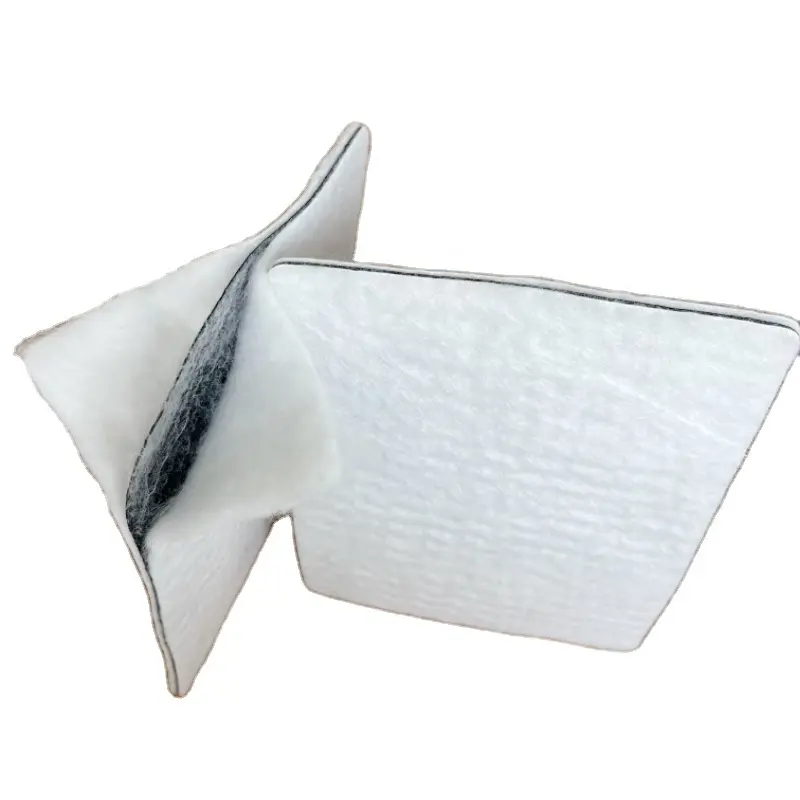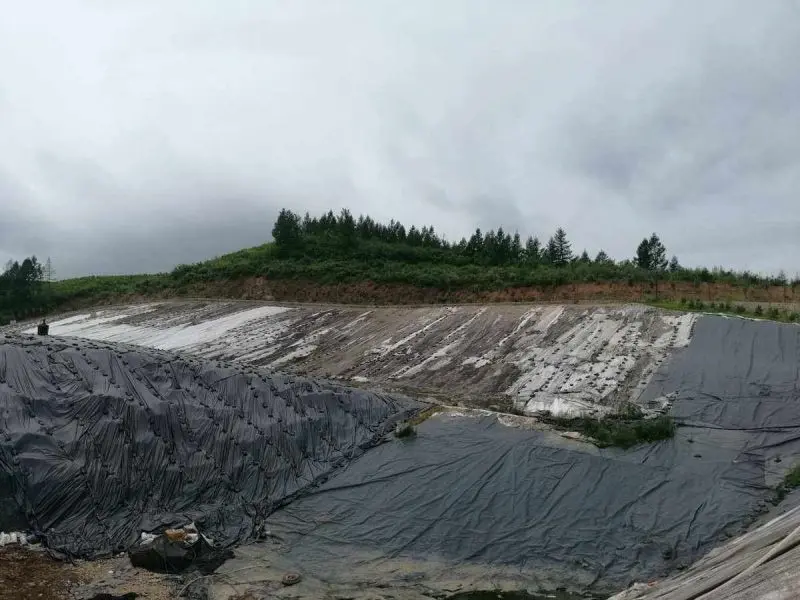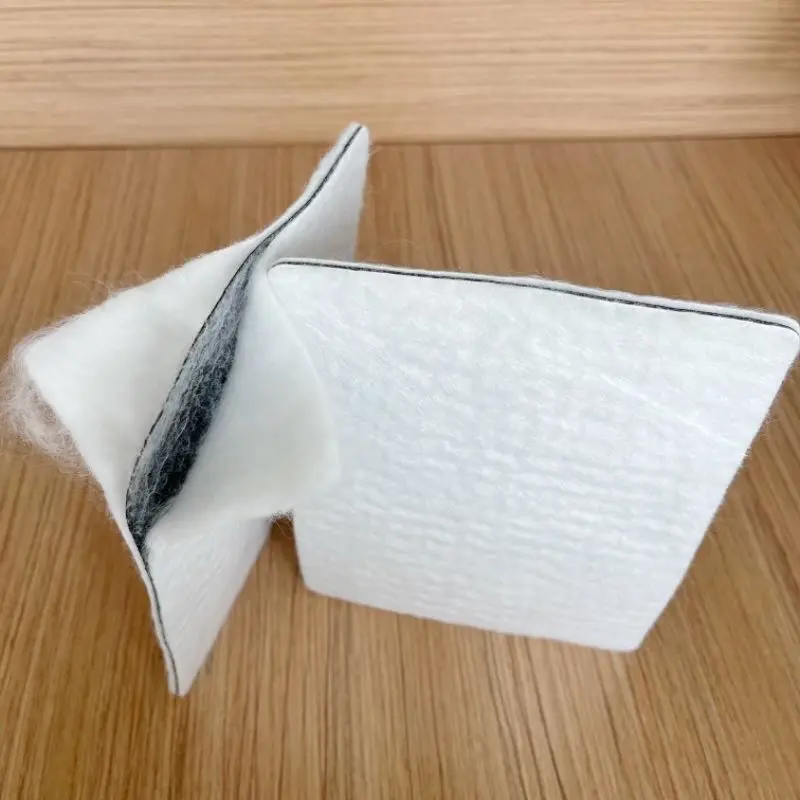![]() Filament composite geomembrane.pdf
Filament composite geomembrane.pdf
Types of composite geomembranes
Composite geomembranes are essential components in various civil engineering and environmental protection projects, providing impermeability and stability to structures such as landfills, ponds, reservoirs, and containment facilities. These composite materials are typically categorized into two main types: "one geotextile plus one geomembrane" and "two geotextile plus one geomembrane."

One geotextile plus one geomembrane
The "one geotextile plus one geomembrane" composite geomembrane consists of a single layer of geotextile and a single layer of geomembrane. The geotextile layer serves multiple functions, including filtration, protection against punctures, and drainage, while the geomembrane layer provides impermeability to prevent the passage of liquids and gases. This type of composite geomembrane is often utilized in applications where moderate impermeability requirements are sufficient, such as in landfill bottom liners or secondary containment systems.
674710.webp)
Two geotextile plus one geomembrane
Conversely, the "two geotextile plus one geomembrane" composite geomembrane features two layers of geotextile sandwiching a central layer of geomembrane. Both geotextile layers offer protection to the geomembrane, enhancing its puncture resistance and mechanical strength. Additionally, the geotextile layers facilitate filtration and drainage, ensuring proper water management within the structure. This type of composite geomembrane is commonly employed in projects demanding high impermeability performance, such as reservoirs, ponds, and areas with unstable subgrades.
Differences of the two composite geomembrane
Composite geomembranes are essential components in various civil engineering and environmental applications, providing containment and protection against seepage, leakage, and environmental hazards. Two common types of composite geomembranes include those with one geotextile plus one geomembrane and those with two geotextiles plus one geomembrane. Understanding the differences between these two types is crucial for selecting the most suitable solution for specific project requirements.
Composite Geomembrane with One Geotextile Plus One Geomembrane:
Construction: This type of composite geomembrane consists of a single geotextile layer bonded to a geomembrane layer.
Functionality: The geotextile layer provides reinforcement, drainage, and filtration functions, while the geomembrane layer offers impermeability and containment properties.
Applications: Common applications include landfill liners, pond liners, canal lining, and environmental containment projects where a balance of filtration, reinforcement, and impermeability is required.
Composite Geomembrane with Two Geotextiles Plus One Geomembrane:
Construction: This type of composite geomembrane features two geotextile layers sandwiching a geomembrane layer.
Functionality: Both geotextile layers provide reinforcement, drainage, and filtration functions, while the geomembrane layer ensures impermeability and containment.
Applications: Typically used in high-stress applications such as mining, tunneling, and reservoir lining, where enhanced tensile strength, tear resistance, and dimensional stability are required.
Key Differences Between the Two Types:
Number of Geotextile Layers: The primary difference lies in the number of geotextile layers present in the composite geomembrane construction, affecting its overall reinforcement, filtration, and drainage capabilities.
Stress Resistance: Geomembranes with two geotextile layers offer increased stress resistance and stability compared to those with one geotextile layer, making them suitable for high-stress applications.
Applications: While both types of composite geomembranes offer containment and protection, the choice between them depends on the specific project requirements, environmental conditions, and desired performance characteristics.
Understanding the differences between composite geomembranes with one geotextile plus one geomembrane and two geotextiles plus one geomembrane is essential for selecting the most appropriate solution for civil engineering and environmental projects. Whether balancing filtration and impermeability or requiring enhanced strength and stability, choosing the right composite geomembrane type ensures optimal performance and longevity in diverse applications.
Technical Parameters | Unit weight g/㎡ | |||||||||
400 | 500 | 600 | 700 | 800 | 900 | 1000 | ||||
Thickness of PE Membrane mm | 0.2-0.35 | 0.3-0.6 | ||||||||
Common Spec. | one geotextile plus one geomembrane | 150/0.25 | 200/0.3 | 300/0.3 | 300/0.4 | 300/0.5 | 400/0.5 | 400/0.6 | ||
two geotextile plus one geomembrane | 100/0.2/100 | 100/0.3/100 | 150/0.3/150 | 200/0.3/200 | 200/0.4/200 | 200/0.5/200 | 250/0.5/250 | |||
Unit area weight deviation % | -10 | |||||||||
Breaking Strength KN/M≥ | 5 | 7.5 | 10 | 12 | 14 | 16 | 18 | |||
Breaking elongation % | 30-100 | |||||||||
Tear Strength KN | 0.15 | 0.25 | 0.32 | 0.4 | 0.48 | 0.56 | 0.62 | |||
CBR bursting strength KN≥ | 1.1 | 1.5 | 1.9 | 2.2 | 2.5 | 2.8 | 3 | |||
Vertical seepage coefficient cm/s | 10--12 | |||||||||
Resist Hydraulic pressure MPa≥ | 0.4-0.6 | 0.6-0.1 | ||||||||
In conclusion, both the two types of composite geomembranes play crucial roles in modern civil engineering and environmental protection applications, offering versatile solutions to address various impermeability challenges and ensure the long-term integrity of engineered structures. One geotextile plus one geomembrane" is a simpler composite geomembrane suitable for basic impermeability needs, while "two geotextile plus one geomembrane" is a more complex structure suitable for projects requiring higher impermeability performance and engineering safety. The choice of the appropriate type of composite geomembrane should be based on specific project requirements and environmental conditions.
Supply High-quality composite geomembranes
As one of China's leading manufacturers in the field, we take pride in our expertise and commitment to producing high-quality composite geomembranes. With a focus on excellence and innovation, we strive to meet the diverse needs of our global clientele by delivering reliable containment solutions for various civil engineering and environmental applications. Our dedication to quality assurance and customer satisfaction ensures that our composite geomembranes consistently meet or exceed industry standards, making us a trusted partner for projects worldwide.
992.webp)
115.webp)
536.webp)
338.webp)

503.webp)
759.webp)

855.webp)